Pros: No gas; blistering acceleration; relatively agile handling; front trunk and other innovative features
Cons: Limited body style and trim variations; less range than ICE trucks; availability
Is this the future of the pickup truck? The Ford F-150 Lightning is a stunning achievement that proves that an electric pickup isn’t only possible, it’s actually better in most respects. True, bladder-busting road trips, especially while towing, will be more difficult (though certainly not impossible) and those with off-roading on their minds will find better options under the F-150 umbrella (though the Lightning’s standard skid plates and locking rear differential help for soft-roading duty). It will also likely take you awhile to actually take one home. Still, the Lightning’s robust performance (how does 775 pound-feet of torque sound?), conventional full-size pickup body and general normalness will make truck vets feel sufficiently at home, while innovations like the Pro Power Onboard system, 14-cubic-foot front trunk and independent rear suspension are game changers. Basically, the Lightning is both a bold leap forward and comfortably familiar.
Although its number of versions isn’t as extensive as the standard F-150, the Lightning lineup still includes a Pro work truck, XLT entry-level consumer model, Lariat near-luxury trim level and the range-topping, luxurious Platinum (pictured above). You’re also restricted to a SuperCrew cab, 5.5-foot bed and all-wheel drive. Yes, “all” rather than “four.” There’s no transfer case or 4x4 system here: the front wheels are powered by one motor; the rear wheels are powered by another. Although torque is a constant 775 pound-feet, the amount of horsepower differs by battery. The first three trim levels come standard with a battery good for an EPA-estimated 230 miles that helps yield 426 hp, while the available Extended-Range battery ups that total to either 300 or 330 miles, and yields 563 hp.
This electric powertrain, plus the independent rear suspension and a whole lot of battery weight results in a substantially different, and better, driving experience. The Lightning feels more agile and less cumbersome, while its ride is more settled and comfortable. Obviously, its acceleration is like nothing you’ve experienced in a truck before, and the one-pedal driving feature makes navigating traffic far more pleasant (as does the BlueCruise hands-free driving system). Whether you’ve driven trucks for years or you’d be a new adopter, the Lightning makes for a friendly transition. And considering just how much attention it got during our test, it seems like there’s a ton of interest from both groups. We think they’d be well-served to check out the Lightning, because we’re certainly smitten.
Interior & Technology | Passenger & Cargo Space | Performance & Fuel Economy
What it’s like to drive | Pricing & Trim Levels | Crash Ratings & Safety Features


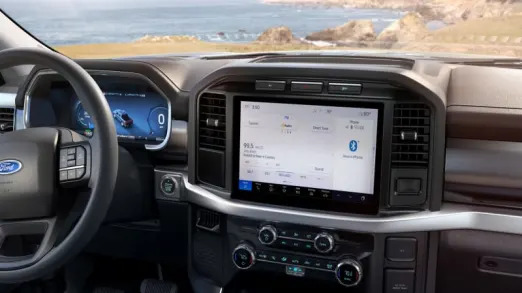
What are the F-150 Lightning interior and in-car technology like?
The Lightning offers two dash designs. The Pro and XLT come with one you’d find in a regular F-150, complete with a standard 12-inch touchscreen that’s an option on most of its gas-powered siblings. The Lariat and Platinum, meanwhile, get the same 15.5-inch portrait-oriented touchscreen found in the Mustang Mach-E, which necessitated a different dash design. Besides the bigger screen, this upgrade features a different interface (dubbed Sync 4A) that may have a steeper learning curve than the standard Sync 4 system, but it’s generally easy to use and utilizes its extra screen real estate well. By contrast, the standard 12-inch screen has basically the same interface as Ford’s 8-inch unit, but everything’s just blown up.
We can’t say that either design is as visually appealing as what you’d find in a Ram 1500 or the impressively redesigned upper trim levels of the Chevy Silverado and GMC Sierra, nor are the materials quite as premium. The Platinum in particular doesn’t look or feel as luxurious as what you’d find in its competitors’ range-topping versions. We don’t think that’s a deal-breaker: The F-150 Lightning cabin is still a pleasant place to spend time, especially without all that engine noise or live-rear-axle jiggling.
Besides the screen, the interior is pure F-150 SuperCrew. You’d be hard-pressed to know you’re in something other than a regular old XLT, Lariat or Platinum. The F-150’s five-passenger seating layout is standard, which means the Lightning also offers the unique center console with an armrest lid that unfolds forward to become a flat surface to place a laptop, paperwork or road-side picnic. To make this origami possible, the shifter uniquely motors forward into a recess, though only when parked. We’ll be curious to see how much owners utilize and appreciate this functionality. The rest of the center console features useful storage, while the back seat features a unique, flip-up floor bin.
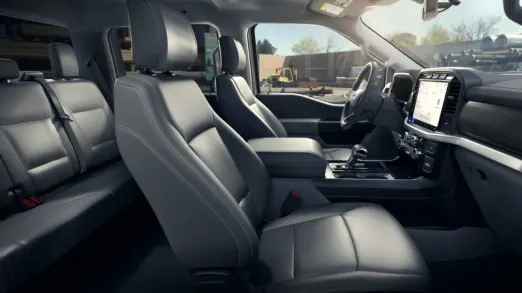
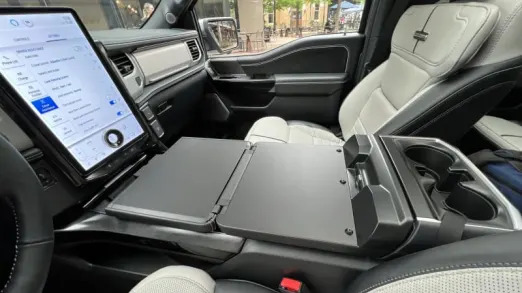
How big is the Lightning?
The Lightning is only available with the combination of SuperCrew cab, the five-passenger seating configuration and 5.5-foot bed. That’s a popular combo, and like all full-size crew cabs, it benefits from a vast amount of passenger space, but it obviously limits your choices.
You do gain something immensely valuable with the Lightning, however; something you probably never thought you’d want before: a frunk. You see, removing the engine from an F-150 results in a 14.1 cubic-foot trunk under the hood (or front trunk, hence “frunk”). You no longer have to risk getting things wet or stolen by putting them in the bed, or need to rely on a bed tonneau cover for those same reasons. You also won’t have to rely as much on the flip-up back seat and the flat floor underneath. Being able to put a stroller, camp chairs, groceries and luggage for the airport in the frunk was quite simply a game-changer during our test. It’s also pretty fun to see people’s reaction when you remote-open a truck’s hood to reveal some Target bags instead of a V8.
This is still a truck, though, and this seems like a good place to mention the unique bed elements the Lightning shares with other F-150s. One is familiar: the tailgate’s pop-out assist step that makes repeatedly climbing up and down out of the bed a game-changing quick-and-easy process. The second is newer: the Pro Power Onboard electrical system that allows the F-150 to function as mobile generator and power station. A 2.4-kilowatt system is standard on the Lightning, and features multiple 120-volt outlets throughout the truck: two each in the cab and bed, plus four in the frunk. This is the same system that comes standard on the F-150 Hybrid. The 9.6-kW system (optional on Pro and XLT, standard on Lariat and Platinum) adds a second pair of 120V outlets and a 240-volt outlet to the bed. Besides adding some serious power to whatever task you might need when away from home, Pro Power actually gives you the ability to power your home in the event of a power loss. We’ve already seen the Hybrid’s available 7.2-kW system come up big for owners, and the Lightning has even greater capability.
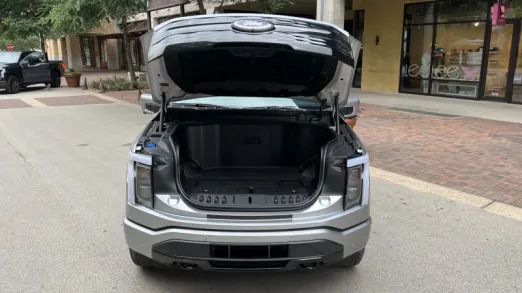

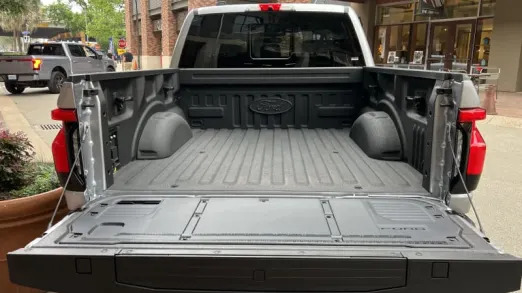

What are the F-150 Lighting’s range, performance and towing specs?
The key element to consider is the battery. Standard on all but the Platinum is a 98-kilowatt-hour battery – which is massive, but then so is the Lightning – resulting in a hardly eye-popping 230 miles of range. With a motor on each axle providing standard all-wheel drive (there’s no 4x4 transfer case here with 4Lo, but then, electric motors don’t need one), combined output with the standard battery is 452 hp and 775 lb-ft of torque. Ford says it will go from zero to 60 mph in 5 seconds. That’s quicker than a Raptor. Max payload is 2,000 pounds, while the towing capacity is 7,700 pounds with the optional Max Trailer Tow Package.
The Extended-Range battery is optional on all but the Platinum, which includes it as standard equipment. This massive 131-kWh pack increases range to 330 miles on the lower three trims, or 300 miles for the Platinum. Output increases to 580 horsepower, but torque remains the same at 775 lb-ft. The 0-60 time falls to the mid-4-second range, which is comparable to a Ram TRX. Max payload lowers to 1,800 pounds (blame the added battery weight), but the Max Trailer Tow Package ups towing capacity to 10,000 pounds.
One other element to consider: charging. The Extended-Range battery has a more powerful onboard charger, meaning it charges at a comparable rate despite the bigger pack. Both max out at a rate of 150 kW, which would in theory allow you to recharge either battery from 10 to 80% capacity in a little longer than 40 minutes at a 150- or 350-kW fast charger. (Learn more about all this newfangled charging business here).

What's the Lightning like to drive?
The Lightning is like no other truck you’ve driven before. It’s whisper-quiet, for one, which is pretty bizarre considering many think that pickups are better when louder. Acceleration is neck-snappingly quick, with an immense amount of torque available instantaneously. That goes for either battery pack. The steering sure seems the same as the impressively responsive and well-weighted system introduced for the ‘21 F-150 (including its improved wheel position), and given the independent rear suspension with coil springs, the Lightning feels like it shrinks around you. It feels more agile and planted than any other full-size truck, and it’s easy to forget just how big it is. Well, at least if you’re used to driving a truck. If you’re not, it’ll still feel enormous.
The ride quality also benefits from the independent rear suspension, but as the regular F-150’s ride comfort has become awfully sophisticated, it’s not the advantage we might have expected a few years ago. Still, there’s no hiding a body-on-frame construction. Much like a Ford Expedition with its combination of body-on-frame, independent rear end and coil springs, you still feel shudders through the structure over big impacts and occasional vibrations you wouldn’t feel in a unibody design. This is key difference between the Lightning and a Rivian R1T, in case you’re wondering.
What other Ford F-150 Lightning reviews can I read?
Ford F-150 Lightning First Drive
Dive deeper into the Lightning's engineering and unique features, plus our most substantial driving impressions.
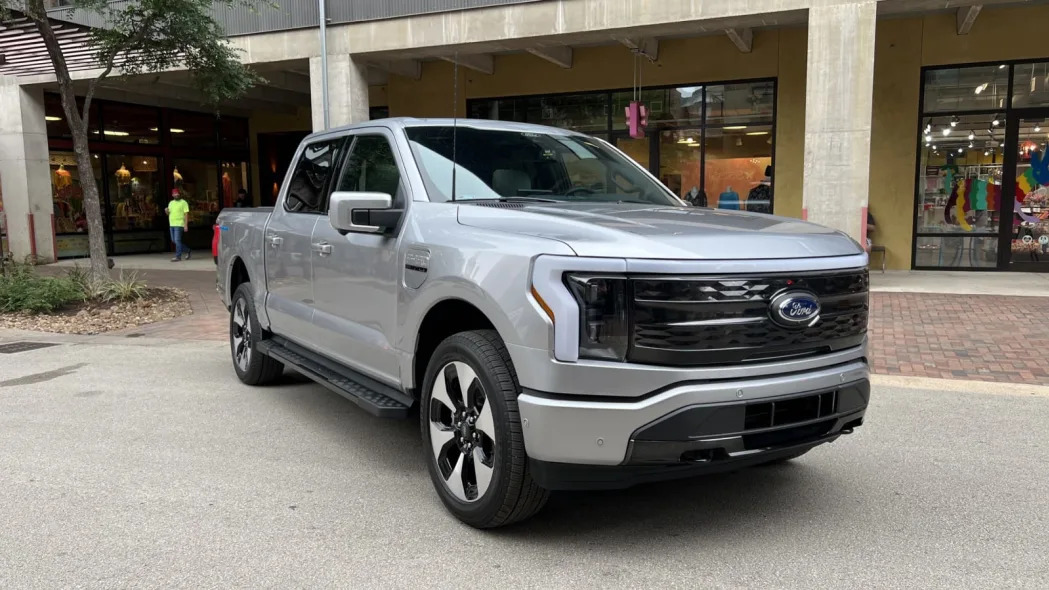
F-150 Lightning Pro Revealed
More detail about the base Lightning Pro, which is mostly intended for businesses.
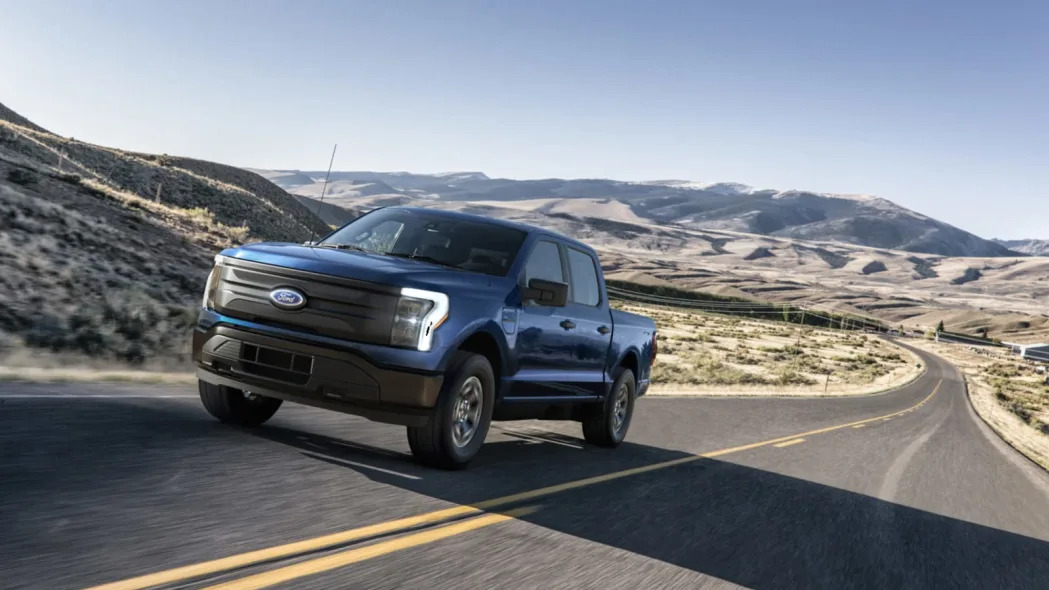
What is the F-150 Lightning price?
At the time of this writing, the Lightning’s price is a moot point as 2022 order books are closed, 2023 order books aren’t open yet and any sitting on dealer lots will be subject to near-certain dealer markups.
That said, here’s what the MSRP was for each 2022 Lightning trim level, including the $1,795 destination charge. All were/are eligible for the $7,500 federal tax credit.
Pro: $41,769
XLT Standard Battery: $54,769
XLT Extended-Range: $74,269
Lariat Standard Battery: $69,269
Lariat Extended-Range: $79,269
Platinum: $92,669
What are the F-150 safety ratings and driver assistance features?
Every Lightning comes standard with the Ford Co-Pilot360 2.0 suite of driver assistance technologies. This includes automatic emergency braking with forward collision warning and pedestrian detection, blind-spot and rear cross-traffic warning, lane-keeping assist, rear parking sensors, reverse braking assist and auto high beams. Standard on the Lariat and Platinum, and optional on the XLT, is the Co-Pilot 360 Assist upgrade that adds evasive steering assist, built-in navigation, speed sign recognition and adaptive cruise control with stop-and-go capability and lane-centering steering assist. Optional on the Lariat and standard on the Platinum is Ford’s BlueCruise hands-free highway driving assist and an automated parking system.
The Lightning had not specifically been crash tested by a third party at the time of this writing.
Related Video:









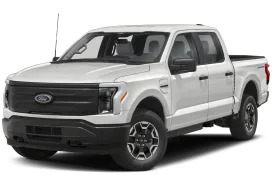
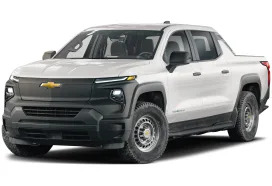
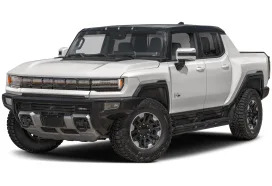

Sign in to post
Please sign in to leave a comment.
Continue